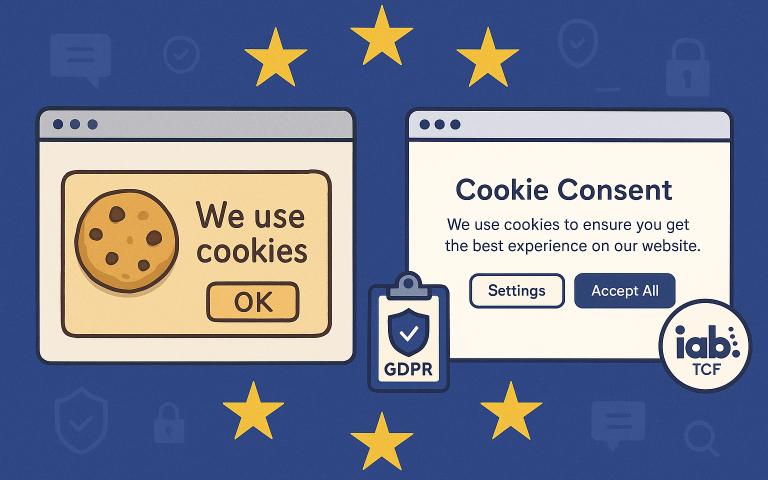Cookie Banner: Why You Need It and Why Custom Solutions Can Backfire
Almost every website today greets visitors with a cookie banner. For users, it looks like a small popup asking for consent. For businesses, it’s a legal mechanism that determines compliance, data accuracy, and even ad performance. Let’s break down what a cookie banner really does, what GDPR, IAB TCF 2.2 and CMPs are, and why building your own banner can lead to trouble.

What Is GDPR and Why It Matters
GDPR (General Data Protection Regulation) is the EU’s data protection framework, effective since 2018. It defines how businesses can collect, store, and use personal data — including cookies and online identifiers.
In short, GDPR requires:
- Transparency — users must know what data is being collected and why.
- Explicit consent — tracking tools can’t load before consent is given.
- Easy withdrawal — users must be able to change or revoke consent at any time.
- Proof — companies must keep records showing when and how consent was obtained.
This means that even analytics or ad scripts (Google Analytics, Meta Pixel, YouTube Embed, Hotjar, etc.) require explicit consent before they can run.
ePrivacy Directive: The Law Behind Cookie Banners
While GDPR sets the general rules, the ePrivacy Directive specifies how cookies and tracking technologies should be handled. Together they establish the rule that:
“Non-essential cookies cannot be set before the user has given explicit consent.”
What Is IAB TCF 2.2 and Why It’s Important
As privacy laws evolved, ad networks needed a unified way to manage user consent. That’s how the IAB TCF (Transparency & Consent Framework) was created by the Interactive Advertising Bureau Europe. The latest version — TCF 2.2 — launched in 2024.
It defines a common language between:
- CMPs (Consent Management Platforms), where consent is collected;
- websites that host the tracking scripts;
- ad and analytics vendors like Google, Meta, TikTok, and Criteo.
When a visitor clicks “Accept all,” the CMP generates a consent string — a standardized signal understood by all major ad platforms. Without TCF 2.2 support, Google and other networks simply ignore your consent data, limiting personalized ads and reporting accuracy.
CMP — The Heart of Consent Management
A Consent Management Platform (CMP) is a tool that displays the banner, stores consent records, and forwards that information to other services like analytics and ads.
Reliable CMPs should:
- Support IAB TCF 2.2 standard;
- Integrate with Google Consent Mode v2 (2024 update);
- Log consent timestamps and policy versions;
- Allow easy category management (Functional, Analytics, Marketing cookies);
- Support multiple languages for EU websites.
Popular CMP providers include Cookiebot by Usercentrics, Didomi, and ConsentManager.
Why a Custom Cookie Banner Is a Bad Idea
Building a banner from scratch may sound simple — a bit of HTML, a localStorage flag — but in practice it creates legal and technical risks.
- No IAB TCF 2.2 compliance. Custom scripts don’t generate valid consent strings, so ad networks ignore them.
- No Google Consent Mode v2 support. Your data and campaign tracking become inaccurate.
- No logging or version control. You can’t prove when and what users consented to.
- Hard to maintain. Privacy rules change frequently — your custom code won’t keep up.
- Risk of fines and ad restrictions. Non-compliant sites can lose access to personalized ads or face GDPR penalties.
If your custom banner doesn’t meet TCF 2.2 and Consent Mode v2 requirements, it’s smarter to switch to a certified CMP such as Cookiebot by Usercentrics and eliminate compliance risks.
Why This Matters for Business
A cookie banner is not just a technical detail — it’s a symbol of transparency and trust. For companies serving EU and UK clients, proper CMP implementation signals professionalism and legal maturity. It also ensures accurate analytics and better marketing performance without regulatory risk.
How to Choose the Right Solution
The best approach is to use a CMP certified under IAB TCF 2.2. It ensures seamless integration with ad platforms, automatic updates for new rules, and proper consent logging. Once configured with Google Tag Manager, you only need to keep your cookie policy text up to date.
Conclusion
A cookie banner isn’t a formality — it’s a core part of your legal and marketing infrastructure. A custom solution might save a few hours of coding but can end up costing lost data, ad restrictions, or GDPR penalties. In modern digital Europe, GDPR and IAB TCF 2.2 compliance are non-negotiable. It’s wiser to invest in a proper CMP implementation than to risk building something that fails under legal or Google audits.
Note: The link to Cookiebot by Usercentrics is an affiliate link. It does not affect our evaluation — you pay the same price, and it helps support this blog.
Get in touch
Need an external audit of Your project?
Tell us your context and the outcome you want, and we’ll suggest the simplest next step.